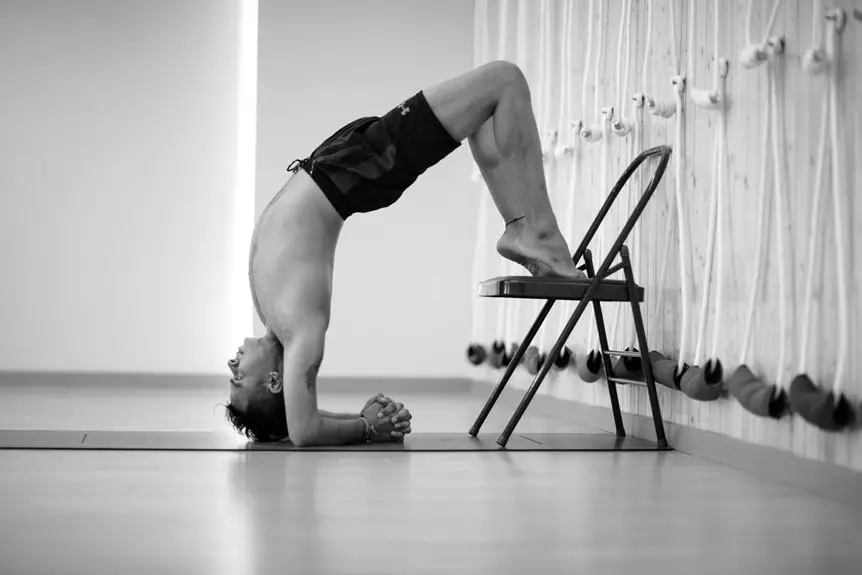Your core muscles are essential for a stable spine and good posture, yet many overlook how their chair can impact these muscles. An ill-designed chair can lead to weakened core strength, affecting your overall well-being. Understanding the connection between your seating choice and core health is crucial. So, what should you look for in a chair to support your core effectively? Let's explore the factors at play and how to make an informed decision.
Table of Contents
Key Takeaways
- Core muscles support the spine and good posture, essential for overall health and stability.
- Chair design, including lumbar support and adjustable features, influences spinal alignment and comfort.
- Prolonged sitting weakens core muscles and reduces muscle activation, leading to poor posture.
- Choosing the right chair can enhance core engagement and promote healthier sitting habits.
- Regular movement and seated exercises can help maintain core strength while using a chair.
Understanding Core Muscles and Their Importance
Understanding core muscles is crucial for your overall health and fitness, especially since they play a key role in stability and movement.
Your core comprises various muscles, including the rectus abdominis, obliques, and transverse abdominis. These muscles support your spine, help maintain good posture, and enable you to perform daily activities efficiently.
When you engage your core, you enhance balance and coordination, reducing the risk of injuries. Strengthening these muscles also contributes to better athletic performance and can alleviate back pain.
Incorporating exercises like planks, bridges, and rotations into your routine will help you build a solid foundation.
The Impact of Chair Design on Posture
Since the design of a chair can significantly influence your posture, it's essential to choose one that promotes spinal alignment and comfort. A well-designed chair supports your lower back, encouraging you to sit upright, which reduces strain on your spine.
Look for adjustable features like seat height and lumbar support to customize the fit to your body. If the chair's seat is too deep or too shallow, it can throw off your alignment, leading to discomfort and fatigue.
Armrests should also be at the right height to prevent shoulder tension. Ultimately, a chair that fits your body properly fosters better posture, allowing you to focus on your tasks without the distraction of discomfort.
Prioritize your chair choice for better long-term health.
How Sitting Affects Core Strength
While you might not realize it, prolonged sitting can weaken your core muscles over time. When you're seated for long periods, your body tends to rely on your chair for support. This reliance causes your core muscles to become underused and less engaged, making them weaker.
Here's a quick look at how sitting impacts your core strength:
| Effect of Sitting | Result on Core Strength |
|---|---|
| Reduced Muscle Activation | Weaker core muscles |
| Poor Posture | Increased core strain |
| Decreased Flexibility | Limited core stability |
To maintain a strong core, it's essential to incorporate regular movement and exercises into your daily routine. This way, you'll counteract the negative effects of sitting and keep your core muscles engaged.
Choosing the Right Chair for Core Health
How can the right chair support your core health? A well-designed chair can make a significant difference in how your core muscles engage while you sit.
Here are three key features to consider when choosing your chair:
- Lumbar Support: A chair with proper lumbar support helps maintain the natural curve of your spine, encouraging better posture and core engagement.
- Seat Height: Opt for a chair that allows your feet to rest flat on the ground. This encourages stability and reduces strain on your core.
- Adjustability: Look for a chair that can be adjusted to fit your body. An adjustable chair promotes comfort and supports active sitting, which can enhance core strength.
Investing in the right chair can lead to healthier sitting habits and improved core health.
Tips for Enhancing Core Engagement While Seated
To enhance core engagement while seated, focus on your posture and small movements throughout the day.
Sit up straight, keeping your shoulders back and chest open. Engage your abdominal muscles by pulling your belly button toward your spine. You can do this discreetly while working or during meetings.
Incorporate small movements, like shifting your weight from side to side or gently bouncing your legs. Try seated exercises, such as leg lifts or seated twists, to activate your core even more.
Use a stability ball or a chair with minimal back support to challenge your muscles further. Remember to take regular breaks to stand, stretch, and move, as this will help maintain core engagement and improve overall posture.
Frequently Asked Questions
Can Core Muscles Be Strengthened While Working at a Desk?
Yes, you can strengthen your core muscles while working at a desk. Incorporate seated exercises, maintain good posture, and take regular breaks to engage your core, ensuring you stay active throughout your workday.
What Exercises Can I Do in My Chair?
You can do seated leg lifts, torso twists, and seated marches to stay active in your chair. These exercises engage your muscles, improve circulation, and help break up long periods of sitting throughout your workday.
How Often Should I Adjust My Sitting Position?
You should adjust your sitting position every 30 to 60 minutes. Changing your posture helps prevent discomfort and promotes better circulation. It's essential for maintaining focus and staying energized throughout your day.
Are Standing Desks Better for Core Strength?
Standing desks can promote better posture and engage your core muscles more than traditional sitting. By alternating between sitting and standing, you'll enhance strength and stability, helping you maintain a healthier, more active work routine.
What Are the Signs of Weak Core Muscles?
If your posture's slumping, you're experiencing back pain, or you struggle with balance and stability, those could be signs of weak core muscles. Strengthening them can improve overall body function and reduce discomfort.
